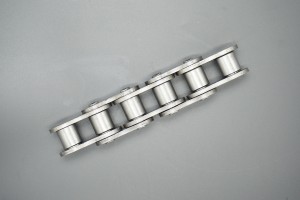In industrial machinery and equipment, roller chains play a vital role in ensuring the smooth and efficient operation of various systems. From manufacturing to agriculture, roller chains are used in a wide range of applications, making them an important part of many industries. However, like any other mechanical part, roller chains have a limited service life, and understanding their life expectancy is critical to maintaining optimal performance and preventing costly failures.
So, what is the lifespan of a roller chain? In this blog, we’ll delve deeper into this topic and explore the factors that affect roller chain service life.
Learn the basics of roller chains
Before we discuss the life expectancy of a roller chain, it is important to understand what a roller chain is and how it works. A roller chain is a mechanical transmission used to transmit power from one shaft to another. It consists of a series of interconnected links with sprockets that mesh with the chain’s rollers, allowing for efficient power transmission.
Roller chains come in a variety of sizes and configurations and are designed to withstand high loads, high speeds and harsh operating conditions. However, despite its strong construction, a roller chain is subject to wear and tear over time, which can eventually lead to failure if not properly maintained.
Factors affecting roller chain life expectancy
The life expectancy of a roller chain can vary depending on a variety of factors, including the quality of the chain, operating conditions and maintenance practices. Let’s take a closer look at these factors:
Quality of the chain: The quality of the roller chain has a significant impact on its service life. High-quality chains manufactured to industry standards and made from durable materials generally have a longer life expectancy than lower-quality chains. When selecting a roller chain for a specific application, it is important to consider factors such as tensile strength, fatigue resistance and corrosion resistance to ensure optimal performance and service life.
Operating conditions: The conditions in which a roller chain is used can also affect its life expectancy. Factors such as temperature, humidity, contamination and shock loads can all cause wear and fatigue, leading to premature failure if not managed properly. For example, roller chains operating in corrosive environments require regular maintenance and protection to prevent rust and deterioration.
Maintenance Practices: Proper maintenance is critical to maximizing the life expectancy of your roller chain. This includes regular lubrication, checking for wear and damage, and prompt replacement of worn parts. Neglecting maintenance can lead to accelerated wear and premature failure, resulting in costly downtime and repairs.
Estimating roller chain life expectancy
While it is difficult to accurately estimate the life expectancy of a roller chain, there are some general guidelines that can help determine when the chain should be replaced. Generally, a roller chain is considered to have reached the end of its useful life when it exhibits excessive wear, stretch, or damage that cannot be corrected through adjustment or repair.
A common way to evaluate the condition of a roller chain is to measure its elongation using a chain wear gauge. As a roller chain wears, the pitch between the rollers increases, causing elongation. When the elongation exceeds the maximum allowable limit specified by the chain manufacturer, it is recommended to replace the chain to prevent further damage and potential failure.
In addition to elongation, other signs of wear and fatigue to watch for include roller wear, pin wear, plate wear and sprocket wear. Regular inspections and measurements can help identify these issues and take timely action to resolve them before they escalate into larger problems.
Importance of replacement and maintenance
Replacing a roller chain at the end of its expected life is critical to maintaining the reliability and safety of the equipment in which it is used. Worn chains are more susceptible to failure, which can lead to unplanned downtime, damage to other components, and personnel safety hazards. Additionally, a failed chain can result in costly lost production and repairs, so proactive maintenance and replacement is a cost-effective investment in the long run.
In addition to replacement, ongoing maintenance practices such as lubrication, cleaning, and sprocket alignment are critical to extending the life of your roller chain. Proper lubrication helps reduce friction and wear, while regular inspections can identify potential problems early enough for timely intervention and corrective action.
It is also important to use the correct lubricant for the chain’s specific application and operating conditions. Different types of lubricants are used in different environments, such as high temperatures, extreme pressure, or exposure to moisture. Using the proper lubricant can help protect your chain from wear, corrosion, and premature failure.
in conclusion
In summary, understanding the life expectancy of roller chains is critical to maintaining the performance and reliability of industrial machinery and equipment. While the exact service life of a roller chain can vary depending on a variety of factors, including chain quality, operating conditions and maintenance practices, regular inspections and proactive maintenance can help extend its life and prevent costly failures.
By adhering to recommended maintenance intervals, using high-quality chain, and implementing proper lubrication and maintenance, businesses can minimize the risk of downtime, extend the life of their equipment, and ultimately reduce overall operating costs. Therefore, investing in the correct maintenance and replacement of roller chains is a critical aspect of ensuring the efficiency and safety of industrial systems.
Post time: Mar-06-2024

